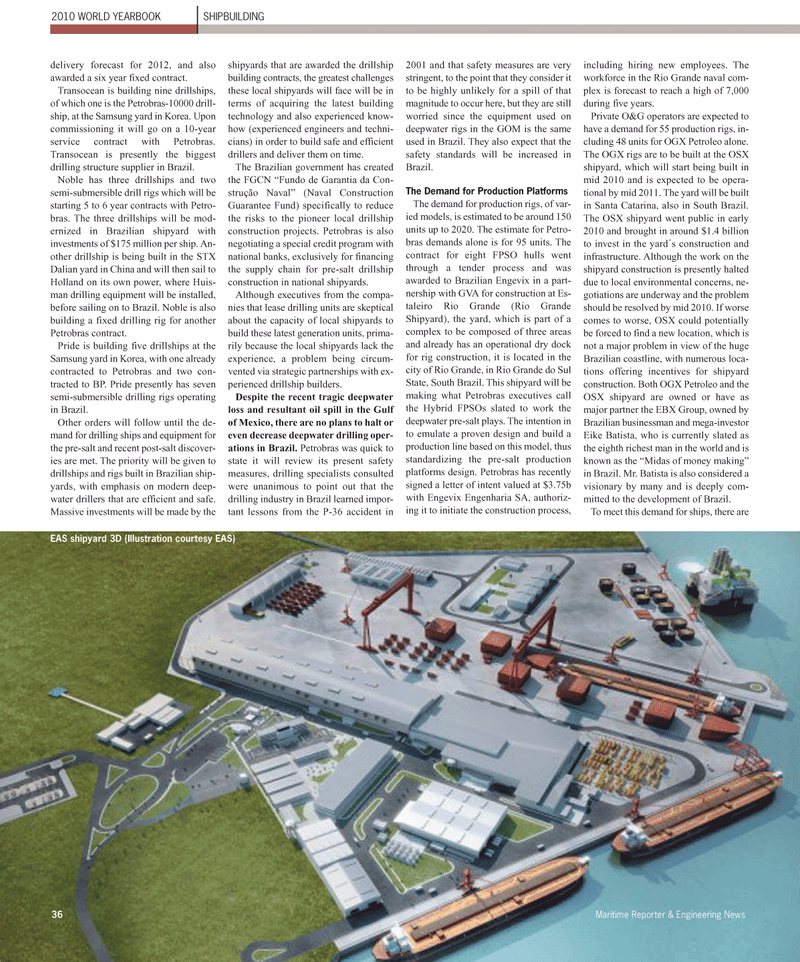
Page 36: of Maritime Reporter Magazine (June 2, 2010)
Read this page in Pdf, Flash or Html5 edition of June 2, 2010 Maritime Reporter Magazine
36 Maritime Reporter & Engineering News delivery forecast for 2012, and also awarded a six year fixed contract.
Transocean is building nine drillships, of which one is the Petrobras-10000 drill- ship, at the Samsung yard in Korea. Upon commissioning it will go on a 10-year service contract with Petrobras.
Transocean is presently the biggest drilling structure supplier in Brazil.
Noble has three drillships and two semi-submersible drill rigs which will be starting 5 to 6 year contracts with Petro- bras. The three drillships will be mod- ernized in Brazilian shipyard with investments of $175 million per ship. An- other drillship is being built in the STX
Dalian yard in China and will then sail to
Holland on its own power, where Huis- man drilling equipment will be installed, before sailing on to Brazil. Noble is also building a fixed drilling rig for another
Petrobras contract.
Pride is building five drillships at the
Samsung yard in Korea, with one already contracted to Petrobras and two con- tracted to BP. Pride presently has seven semi-submersible drilling rigs operating in Brazil.
Other orders will follow until the de- mand for drilling ships and equipment for the pre-salt and recent post-salt discover- ies are met. The priority will be given to drillships and rigs built in Brazilian ship- yards, with emphasis on modern deep- water drillers that are efficient and safe.
Massive investments will be made by the shipyards that are awarded the drillship building contracts, the greatest challenges these local shipyards will face will be in terms of acquiring the latest building technology and also experienced know- how (experienced engineers and techni- cians) in order to build safe and efficient drillers and deliver them on time.
The Brazilian government has created the FGCN “Fundo de Garantia da Con- strução Naval” (Naval Construction
Guarantee Fund) specifically to reduce the risks to the pioneer local drillship construction projects. Petrobras is also negotiating a special credit program with national banks, exclusively for financing the supply chain for pre-salt drillship construction in national shipyards.
Although executives from the compa- nies that lease drilling units are skeptical about the capacity of local shipyards to build these latest generation units, prima- rily because the local shipyards lack the experience, a problem being circum- vented via strategic partnerships with ex- perienced drillship builders.
Despite the recent tragic deepwater loss and resultant oil spill in the Gulf of Mexico, there are no plans to halt or even decrease deepwater drilling oper- ations in Brazil. Petrobras was quick to state it will review its present safety measures, drilling specialists consulted were unanimous to point out that the drilling industry in Brazil learned impor- tant lessons from the P-36 accident in 2001 and that safety measures are very stringent, to the point that they consider it to be highly unlikely for a spill of that magnitude to occur here, but they are still worried since the equipment used on deepwater rigs in the GOM is the same used in Brazil. They also expect that the safety standards will be increased in
Brazil.
The Demand for Production Platforms
The demand for production rigs, of var- ied models, is estimated to be around 150 units up to 2020. The estimate for Petro- bras demands alone is for 95 units. The contract for eight FPSO hulls went through a tender process and was awarded to Brazilian Engevix in a part- nership with GVA for construction at Es- taleiro Rio Grande (Rio Grande
Shipyard), the yard, which is part of a complex to be composed of three areas and already has an operational dry dock for rig construction, it is located in the city of Rio Grande, in Rio Grande do Sul
State, South Brazil. This shipyard will be making what Petrobras executives call the Hybrid FPSOs slated to work the deepwater pre-salt plays. The intention in to emulate a proven design and build a production line based on this model, thus standardizing the pre-salt production platforms design. Petrobras has recently signed a letter of intent valued at $3.75b with Engevix Engenharia SA, authoriz- ing it to initiate the construction process, including hiring new employees. The workforce in the Rio Grande naval com- plex is forecast to reach a high of 7,000 during five years.
Private O&G operators are expected to have a demand for 55 production rigs, in- cluding 48 units for OGX Petroleo alone.
The OGX rigs are to be built at the OSX shipyard, which will start being built in mid 2010 and is expected to be opera- tional by mid 2011. The yard will be built in Santa Catarina, also in South Brazil.
The OSX shipyard went public in early 2010 and brought in around $1.4 billion to invest in the yard´s construction and infrastructure. Although the work on the shipyard construction is presently halted due to local environmental concerns, ne- gotiations are underway and the problem should be resolved by mid 2010. If worse comes to worse, OSX could potentially be forced to find a new location, which is not a major problem in view of the huge
Brazilian coastline, with numerous loca- tions offering incentives for shipyard construction. Both OGX Petroleo and the
OSX shipyard are owned or have as major partner the EBX Group, owned by
Brazilian businessman and mega-investor
Eike Batista, who is currently slated as the eighth richest man in the world and is known as the “Midas of money making” in Brazil. Mr. Batista is also considered a visionary by many and is deeply com- mitted to the development of Brazil.
To meet this demand for ships, there are
EAS shipyard 3D (Illustration courtesy EAS) 2010 WORLD YEARBOOK SHIPBUILDING

 35
35

 37
37
